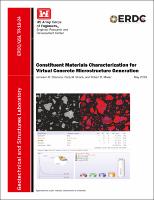Please use this identifier to cite or link to this item:
https://hdl.handle.net/11681/33054Full metadata record
| DC Field | Value | Language |
|---|---|---|
| dc.contributor.author | Shannon, Jameson D. | - |
| dc.contributor.author | Strack, Cody M. | - |
| dc.contributor.author | Moser, Robert D. | - |
| dc.date.accessioned | 2019-06-13T15:24:39Z | - |
| dc.date.available | 2019-06-13T15:24:39Z | - |
| dc.date.issued | 2019-05 | - |
| dc.identifier.govdoc | ERDC/GSL TR-19-24 | - |
| dc.identifier.uri | https://hdl.handle.net/11681/33054 | - |
| dc.identifier.uri | http://dx.doi.org/10.21079/11681/33054 | - |
| dc.description | Technical Report | - |
| dc.description.abstract | This effort was undertaken as a part of the Materials Modeling for Force Protection (MMFP) Military Engineering 6.2 applied research program. One of the main philosophies of MMFP is the creation of a materials-by-design process for predictive properties and material selection capabilities. This report details the capability improvements to facilitate materials-by-design technologies and the collection and characterization of material data to compile and calibrate an integrated materials-by-design model. The Virtual Cement and Concrete Testing Laboratory (VCCTL) was evaluated for suitability in hydration model generation, and various programs were evaluated for initial virtualization of physical elements. To provide model inputs for particle size analysis, X-ray diffraction (XRD), X-ray fluorescence (XRF), scanning electron microscopy (SEM), and energy-dispersive spectroscopy (EDS) testing were conducted on a wide variety of constituent materials, and characterization data were processed included herein. | en_US |
| dc.description.tableofcontents | Abstract .................................................................................................................................... ii Contents .................................................................................................................................. iii Figures and Tables .................................................................................................................. iv Preface .................................................................................................................................... vii Unit Conversion Factors ....................................................................................................... viii 1 Introduction and Background ........................................................................................ 1 1.1 Introduction ........................................................................................................ 1 1.2 Materials Modeling for Force Protection (MMFP) Background ....................... 1 1.3 CEMHYD3D and VCCTL background ................................................................ 3 2 Material Characterization ............................................................................................... 6 2.1 Characterization data required for model ........................................................ 6 2.2 Materials tested ................................................................................................. 6 2.3 Advances in characterization capabilities ........................................................ 7 Scanning electron microscopy and energy dispersive x-ray spectroscopy .............. 7 X-ray diffraction analysis ............................................................................................. 9 Particle size analysis ................................................................................................... 9 3 Data Collection and VCCTL Model Inputs ................................................................... 12 3.1 Data collection archive ................................................................................... 12 3.2 Image processing and phase identification ................................................... 14 3.3 VCCTL inputs ................................................................................................... 18 4 VCCTL Model Outputs .................................................................................................... 20 4.1 Property data outputs .................................................................................... 20 4.2 Data outputs for next level models ................................................................ 26 5 Conclusions .................................................................................................................... 28 Contact Information ............................................................................................................. 29 References ............................................................................................................................. 30 Appendix A: Particle-Size Distribution Results ................................................................. 31 Appendix B: X-Ray Fluorescence Results .......................................................................... 46 Appendix C: X-Ray Diffraction Results ............................................................................... 60 | - |
| dc.format.extent | 86 pages / 8.571 Mb | - |
| dc.format.medium | - | |
| dc.language.iso | en_US | en_US |
| dc.publisher | Geotechnical and Structures Laboratory (U.S.) | en_US |
| dc.publisher | Engineer Research and Development Center (U.S.) | - |
| dc.relation.ispartofseries | Technical Report (Engineer Research and Development Center (U.S.)) ; no. ERDC/GSL TR-19-24 | - |
| dc.rights | Approved for Public Release; Distribution is Unlimited | - |
| dc.source | This Digital Resource was created in Microsoft Word and Adobe Acrobat | - |
| dc.subject | Materials science | en_US |
| dc.subject | Materials--Mechanical properties | en_US |
| dc.subject | Computer simulation | en_US |
| dc.subject | Cement hydration | en_US |
| dc.subject | Computer programs | en_US |
| dc.subject | Virtual microstructure | en_US |
| dc.subject | Modeling | en_US |
| dc.subject | Concrete | en_US |
| dc.subject | Microstructure | en_US |
| dc.subject | Engineering design | en_US |
| dc.title | Constituent materials characterization for virtual concrete microstructure generation | en_US |
| dc.type | Report | en_US |
| Appears in Collections: | Technical Report | |
Files in This Item:
| File | Description | Size | Format | |
|---|---|---|---|---|
| ERDC-GSL TR-19-24.pdf | 8.78 MB | Adobe PDF |  View/Open |